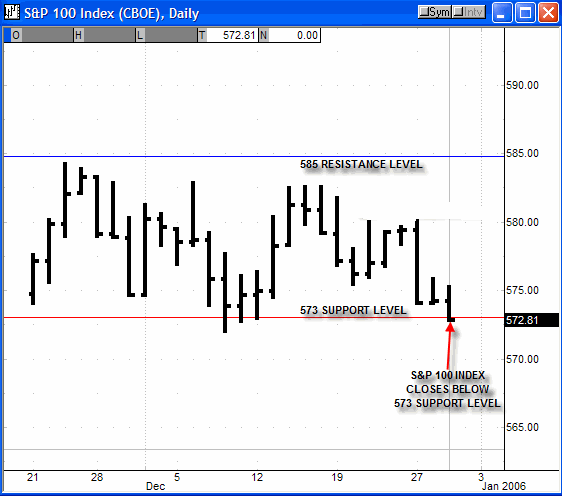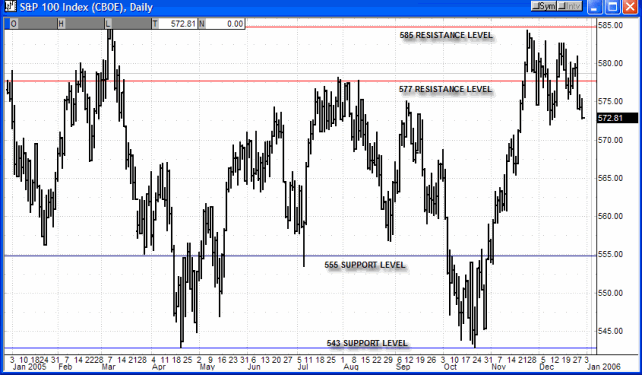My thoughts on the year ahead
As of 7:35 a.m. est., financial markets are set to open lower with the S&P 500 futures trading down 2.75 points, which is 4.0 points below fair value.
The short-term market trend is down, and the intermediate-term market trend is up.
The
(
XEO |
Quote |
Chart |
News |
PowerRating) (S&P 100) index traded lower yesterday down 1.41 points to the 572.81 level.
Financial markets opened moderately higher for the 3rd straight day and were again unable to hold onto these gains. Such price action is indicative of bear market action.
As seen in the chart below, the XEO index closed below the 573 support level yesterday. This support level has been in effect for the past 27 markets sessions. Yesterday’s close was just fractionally below 573. A clear break of the index below 573 will set in motion a nasty decline phase.

From a longer-term perspective, the current breakdown in the stock market is not surprising. Here are the facts. The S&P 100 index closed at the 575.29 level on December 31, 2004. The index is trading at the 572.85 level presently, or is just slightly lower for the entire year.
In looking at the chart below, we see that the S&P 100 index has traded in a very narrow range for most of the year between the 555 and 577 levels.

In essence, nothing has happened in financial markets for the entire year. The total yearly range for the S&P 100 from its lowest to its highest price is 8%, and the index has been locked in a very narrow trading range of about 4% for most of the year.
While very little has happened in financial markets this year, this does not mean that there were not excellent opportunities to profit with options. Unlike common perception, successful options trading isn’t an adrenaline rush. It requires a lot of patience. A good options trader first awaits for the right trading opportunity to arise, and then holds the options while they accrue profits through the passage of time.
Options have the unique characteristic of being able to earn profits when the security underlying the options sits still by using the time depreciation characteristic of the options. This means that by selling options, one can profit when financial market conditions are static as they have been this year.
Using the time depreciation characteristic of options, our recommendations have accrued over 120% in profits (excluding brokerage fees) since July 2004, without a single losing trade recommendation. We have achieved these results while financial markets have been essentially unchanged.
Bottom Line:
Looking to the coming year, it is likely that financial markets will remain in the trading range set forth in the long-term chart above. This means that traders can look to execute long positions when the S&P 100 index declines to between the 543-555 levels and seek to take profits, or enter short positions when the index rises to between the 577-585 levels.
Sincerely, Charles Sachs Chief Options Strategist
Charles Sachs has utilized S&P 100 for the past 14 years, both as a trader and an advisor. He uses 24 proprietary indicators in order to structure options strategies which can generate gains whether the market moves up, down or sideways.
